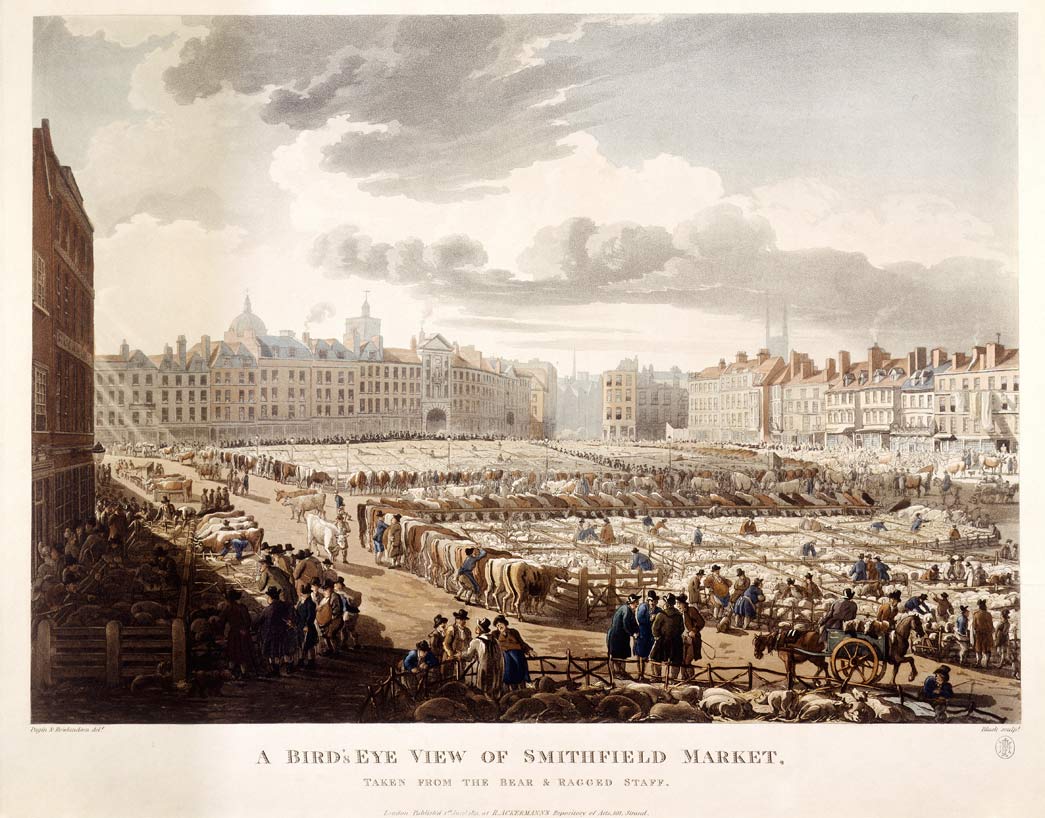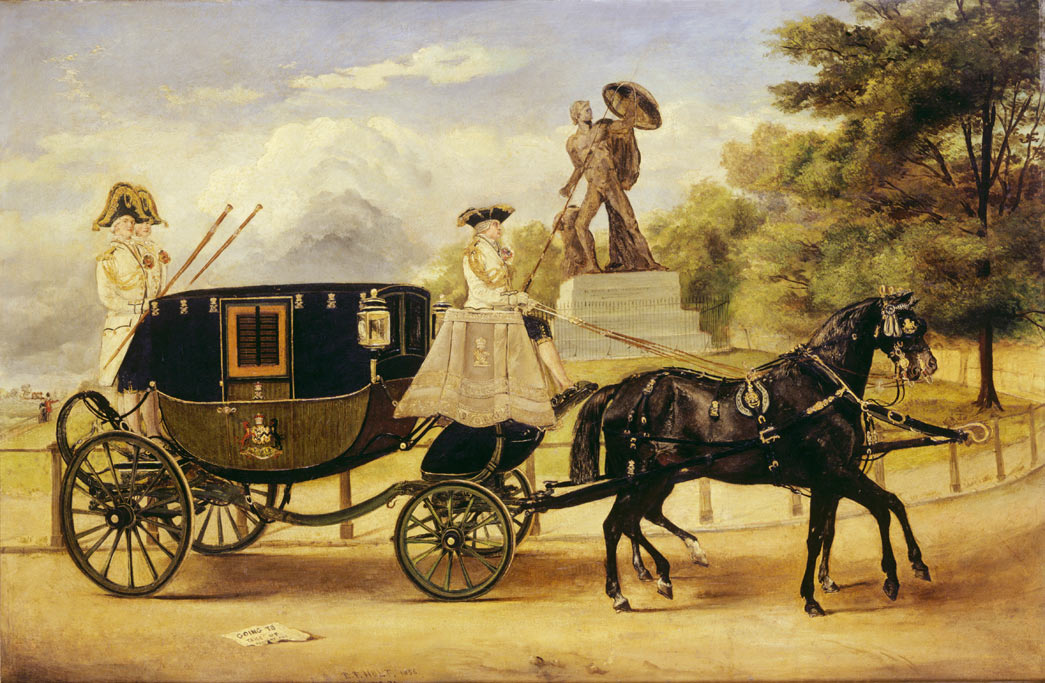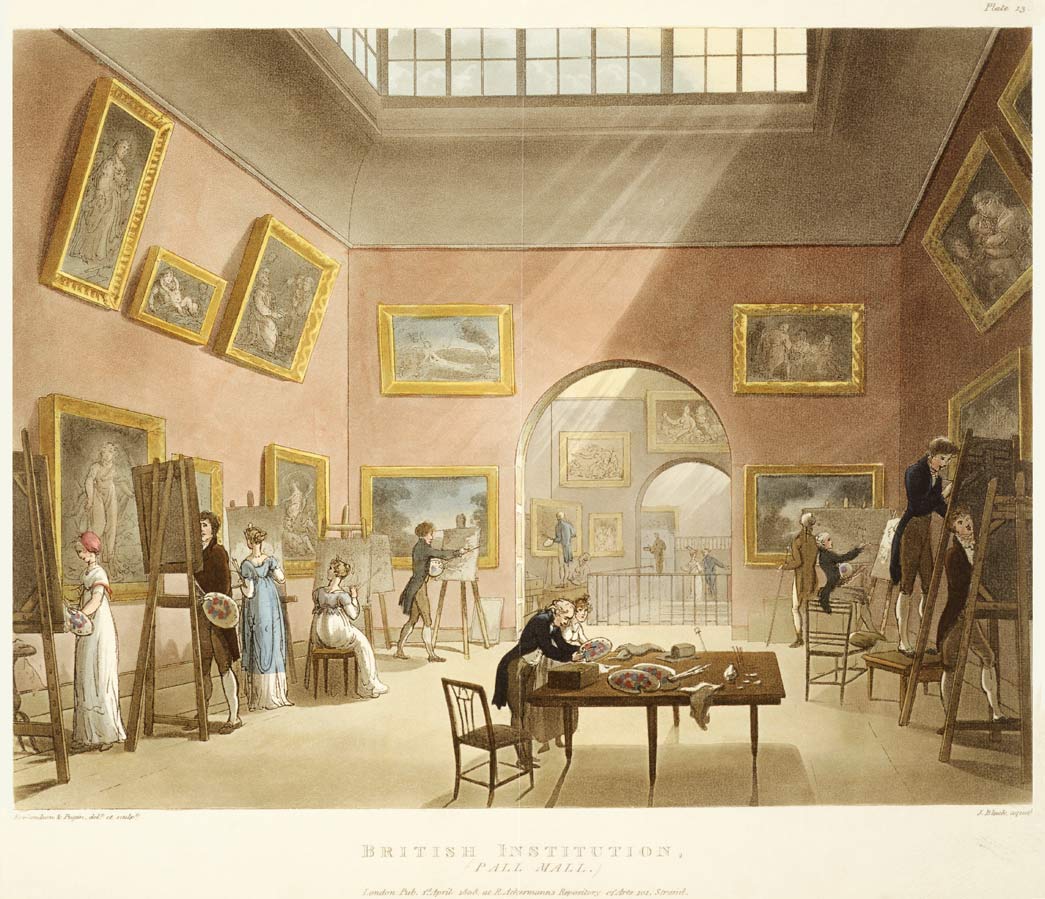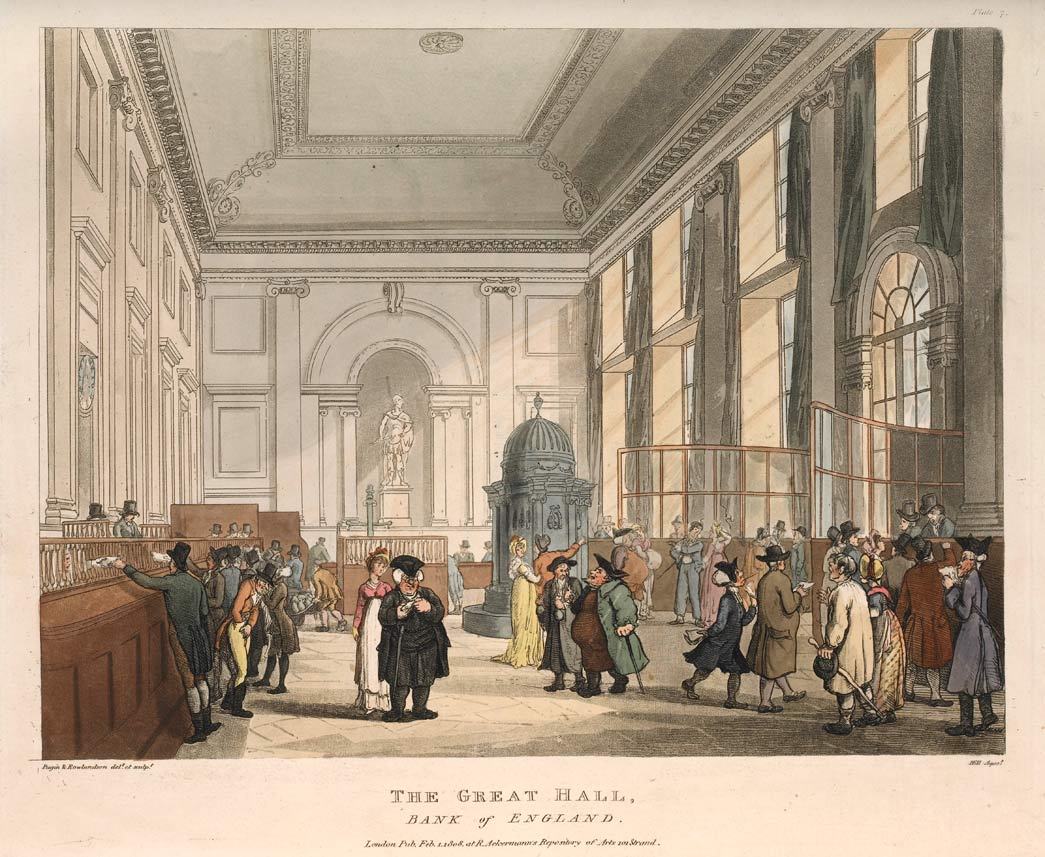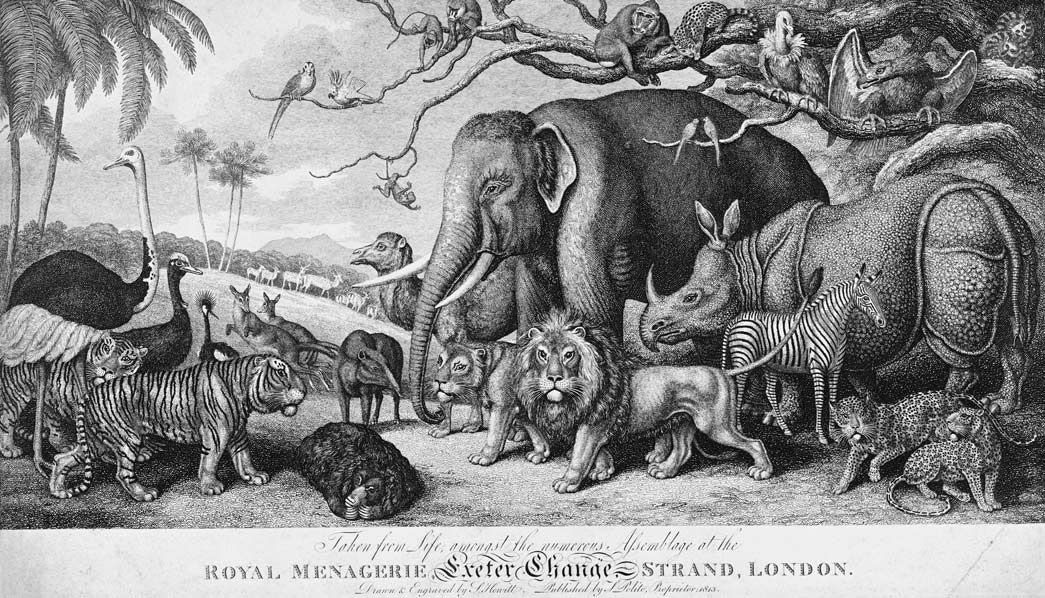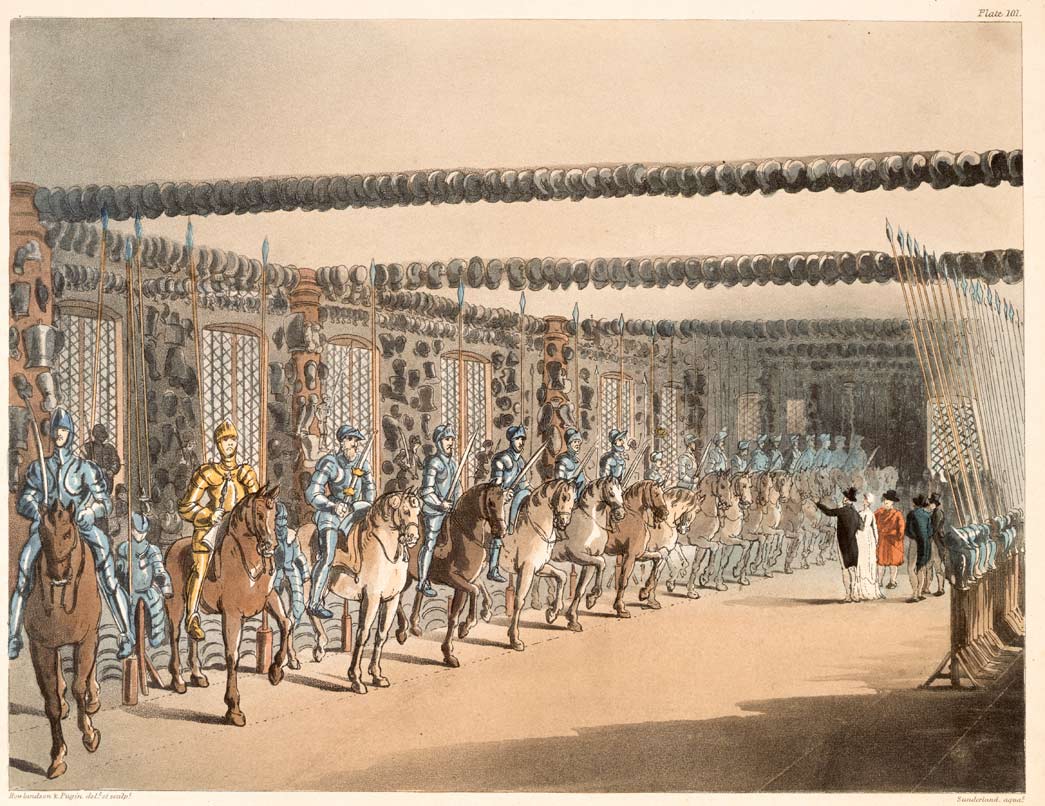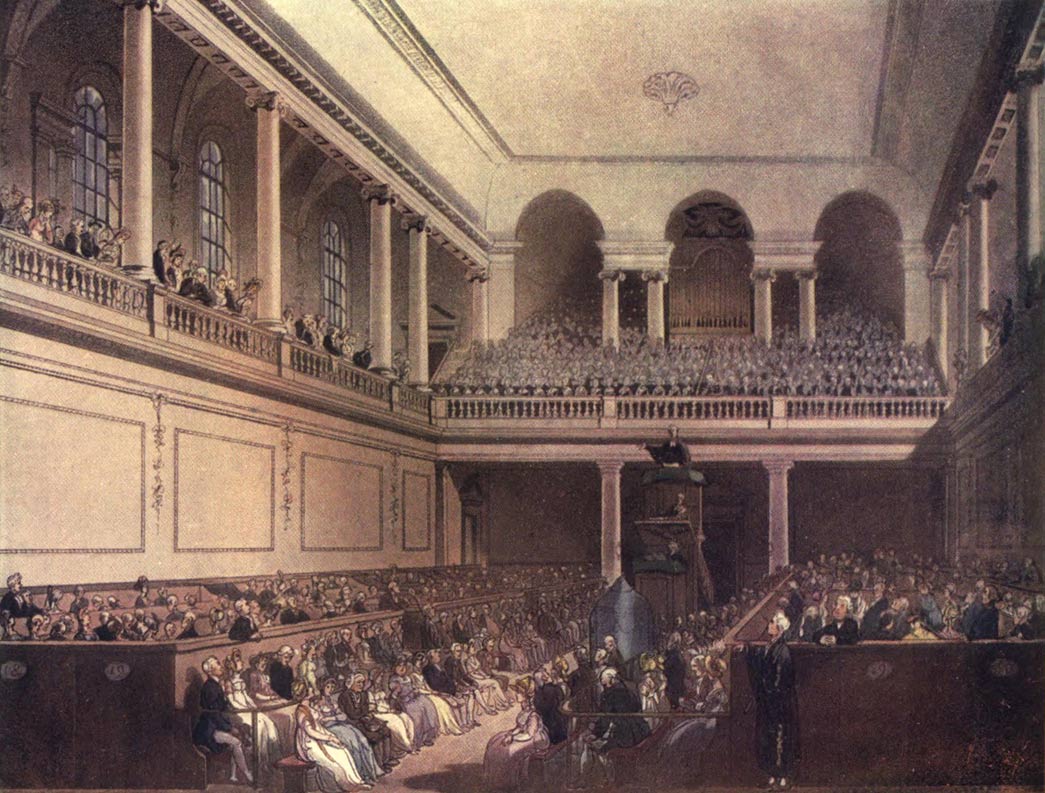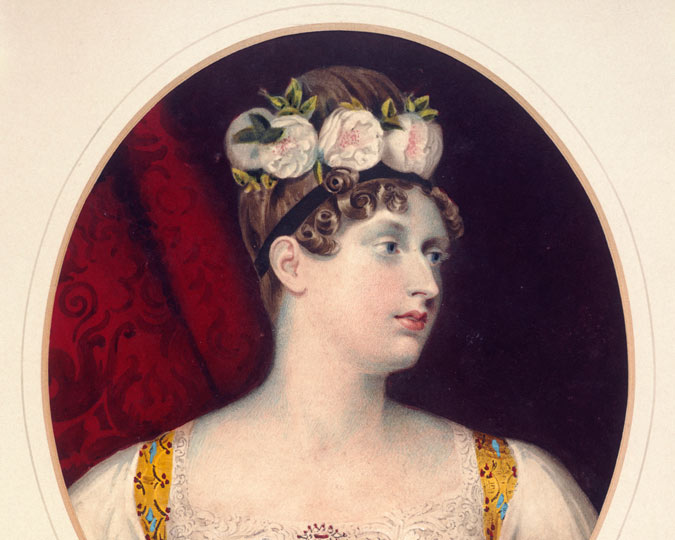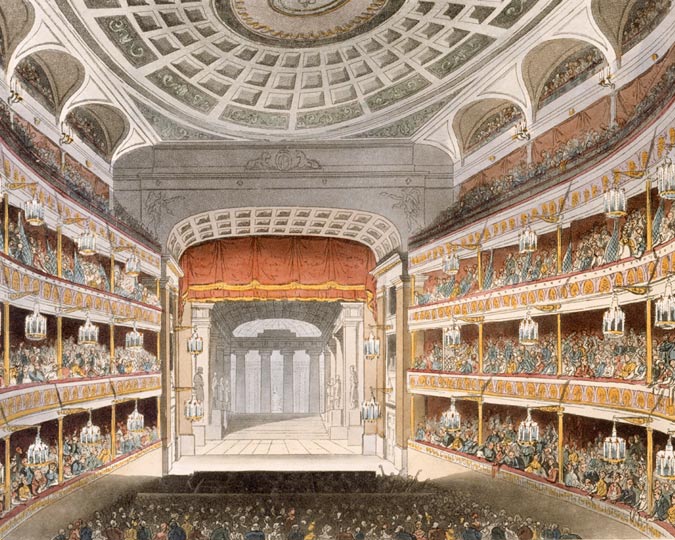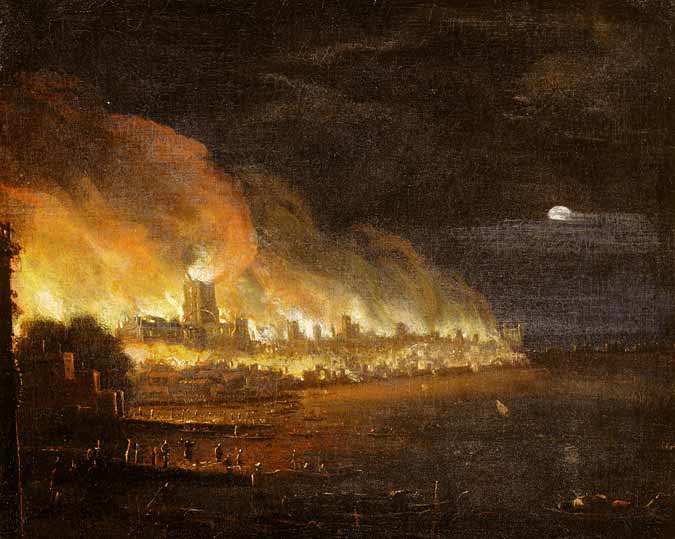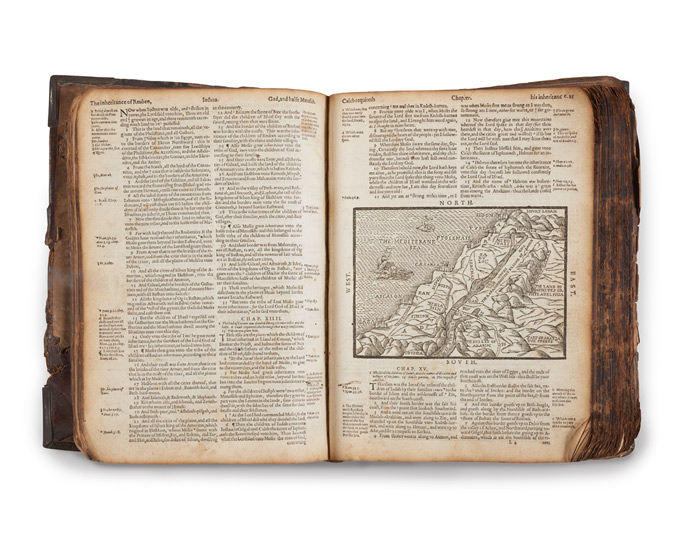In spring 1814, Elizabeth Chivers went on a family trip from Bath to London, visiting dozens of attractions in the capital with her sister Sarah and their uncle. Here are more extracts from her diary (now in the Museum of London library) illustrated with images of London from our collections.
Day 6: Scratching Fanny & murderous gardeners (Saturday 19 March 1814)
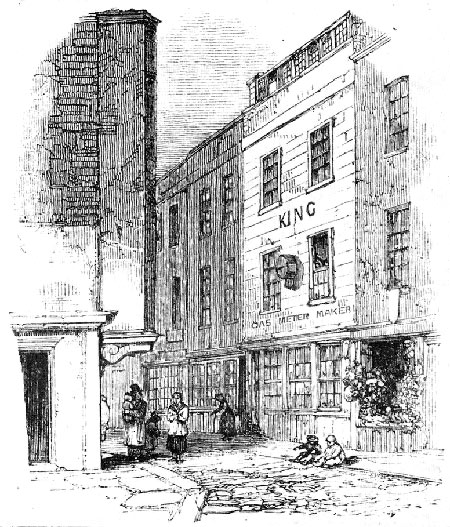
19th century illustration of Cock Lane, site of the 'scratching Fanny' haunting
Published in Charles Mackay's Extraordinary Popular Delusions and the Madness of Crowds, 1852
Our sixth day’s march we began with leaving our Hotel at eleven we passed by Free Masons Hall, Middle Row Holborn, St. Andrews church, Cock Lane famous for the Ghost supposed to have been seen in it some years ago...
[Otherwise known as Scratching Fanny. It was a hoax created for the mundane purposes of money. Richard Parsons tried to frame William Kent (to whom he owed money) for the ‘murder’ of his wife Fanny. The scratching noises were found to be created by Parsons’s daughter Betty.]
[We] saw Smithfield Market, Bartholomews Hospital a most noble building, Blue coat School and Hospital. We called on Mr Dawes, saw the city of London and London Taverns, over London Bridge by King’s Bench prison to the Elephant and Castle Newington. We here took a coach to Kensington Turnpike where we were glad to alight from our vehicle as we found walking so far preferable. We were astonished at the vast number of very elegant houses we passed which were chiefly inhabited by merchants and those who have acquired large fortunes in town.
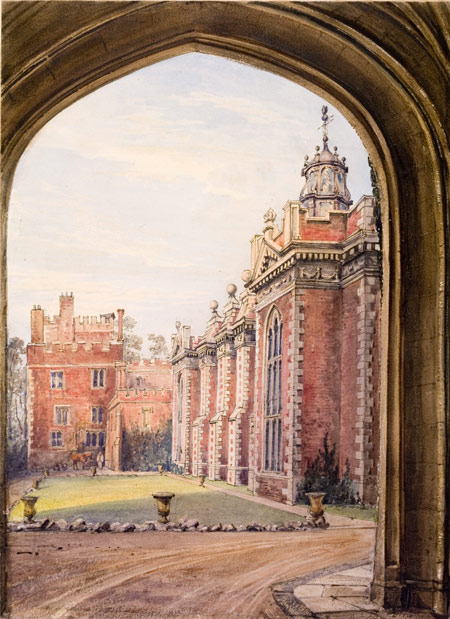
View of Lambeth Palace, 1833
Watercolour, H.W Burgess. ID no. 60.169/3
We saw a very pretty house which my Uncle lived in about twenty years ago. A little further brought us to Mrs Willson’s on Clapham common an old and valued friend of my Uncles who we felt great pleasure in being introduced to. We spent half an hour very pleasantly with her then proceeded on the common to take a view of a noble mansion which my Uncle resided in. It commands a beautiful prospect of the common which is very extensive. It is surrounded with handsome houses, and interspersed with wood and water, and roads which are like gravel walks cross it in different directions. In Summer it must be extremely beautiful. A more charming situation I think cannot be found in the Kingdom, within a delightful ride or walk to town, yet as much the country as if twenty miles from it.
[Great Uncle, William Chivers, had been murdered in his garden at Battersea Rise, by his gardener William Duncan, on 24 January 1807. William Duncan hit Chivers with a spade and on being found guilty of murder was transported to Australia.]
Our late Uncle’s residence and the house next to it now appeared to our view, which has a beautiful effect. The two houses in front being exactly alike, before each is a fine sloping lawn, at the end of both are situated (at a little distance from the house) the offices which are quite complete, behind are the pleasure grounds and gardens which are delightful and are kept in the most exact order, adjoining are two or three very fine fields.
We called on Mrs Hardwick who lives in one of these charming houses which are situated at Battersea Rise. Revisiting this sweet place brought strongly to my memory the pleasant visit I once paid here. We next proceeded homewards thro Lark Hill lane, pass’d Vauxhall Gardens to South Lambeth, went thro the High Street, which is very antient and extremely narrow and gloomy greatly resembling some of the old streets in York, so much so we almost fancied ourselves transported there.
We passed through several little dirty alleys which brought us to the venerable Palace of Lambeth which is inhabited by the Archbishop of Canterbury, it is a very large and antient structure, the entrance to it is very grand. There is a fine walk along a high wall for a considerable distance, from which there is a most beautiful view of the Thames and of Westminster Bridge. We passed White hall, Horse guards, Northumberland House, Chairing Cross, St Martins Church and arrived at our Hotel at five o’clock and relished not a little a bit of good roast beef, after having walked about thirteen miles, we were much pleased with the variety we had seen in this days march which we were fortunate in having a very fine day for it being a hard frost. In the evening we had a hit at Backgammon and at eleven retired to rest.
Day 7: A Sunday in Hyde Park & the Asylum (Sunday 20 March 1814)
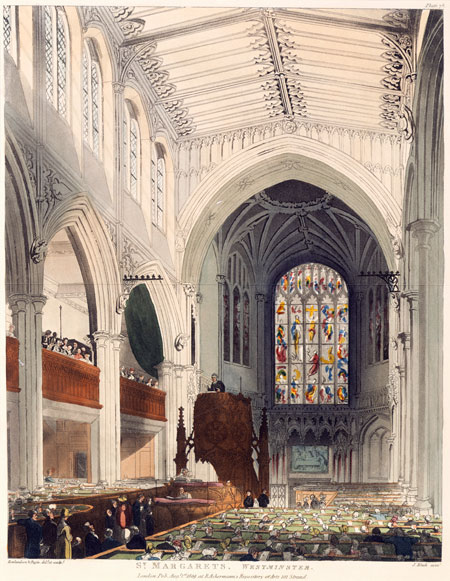
St. Margarets, Westminster, 1809
Published in Microcosm of London, as a typical view of a service in a London church. ID no. Z6905
On our seventh morning we left the Rainbow at half past ten. We set of to attend the Asylum [Royal Asylum for Female Orphans, Westminster Bridge Road, Lambeth] it being Sunday in our way we took a peep into the King’s Mews and saw some of the royal horses. We next came to Spring Gardens to the Royal Parade horse guards where we saw the troop march off in high order which was a fine sight and the band played most beautifully.
At eleven we entered the Asylum. This most excellent institution is for two hundred poor female Orphans who are educated clothed and supported until they are at an age fit for service. The chapel was so crowded it was with great difficulty we procured seats, at the top of it around the Organ sat the Children all dressed exactly alike and particularly neat which was a very fine and affecting sight. The clergyman delivered a most excellent and impressive sermon, which drew tears from many of his congregation, alluding to this great charity and which I think would induce numbers to contribute to its support. In his excellent discourse he introduced the death of Lord Lyttleton who had a wonderful reassessing of his disolution but yet was not prepared for that aweful event.
[Thomas Lyttelton, second Baron Lyttelton (1744-1779?) whose dissolute lifestyle included gambling debts, duels, absconding to Paris with a barmaid, and a spell in prison in Paris after a contretemps in a brothel.]
My Uncle and Father attended his remains to their last home at Hagley in Worcestershire about thirty years ago. We were highly gratified with our visit to the Asylum the fund of which we were sorry to find is in need of the assistance of the charitable and affluent. From it we proceeded to great George Street Westminster having stopped at a pastry cooks by the way and eat a very nice tartlet.
We walked thro the Bird Cage walk St James’s park passed the Queen’s palace and Green park to Hyde park corner and then into Hyde park where we were not a little astonished at the vast number of elegant carriages many of them the first noblemens grand equipage driving backwards and forwards in this beautiful park. We saw the princess Charlotte’s carriage also the Lord Mayor’s superb coach. We returned home thro Piccadilly which from the Hay market to Hyde park corner is about a mile and a half long.
We passed the Dukes of Devonshires & Portlands mansions and thro Leicester fields to our Hotel where we arrived at half past four much pleased with what we had seen and heard this morning and which added greatly to our pleasure the day was beautiful as warm as June, we sat down to dinner at five and in the evening we attended St Paul’s Covent Garden where we heard a good Sermon and a very fine Organ. At our return we took our tea and retired to rest about our usual hour.
Day 8: Pantomimes and tragedies (Tuesday 22 March 1814)
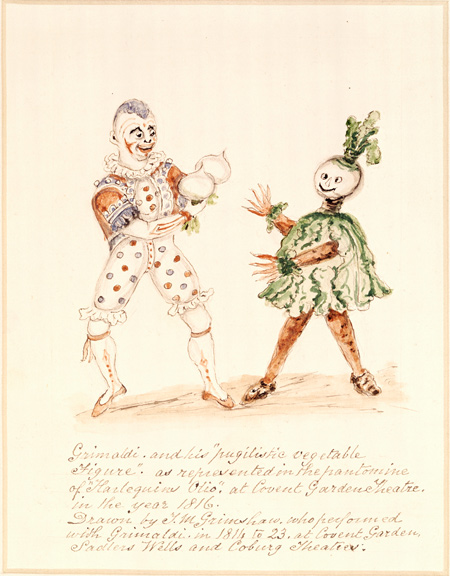
Grimaldi and his 'pugilistic vegetable figure'
Watercolour of the clown Joseph Grimaldi performing a pantomime at Covent Garden Theatre, 1816.
Our eighth morning to our sorrow proved wet, the first rain we had since we left Bath a very fortunate circumstance for us therefore we ought not to murmur at the change in the weather being favoured with it so long fine. In the morning Mr Brice called upon my Uncle to invite us to visit them. After breakfasting and reading the papers my Uncle set off to call on Mr Prowet and we amused ourselves indoors. We were entertained with watching those dashing light airy Vehicles Hackney coaches, which are drawn by such a variety of fine fat frisky horses drove by such smart spruce looking coachmen, who appeared greatly to enjoy the rainy day as it occasioned their being in great request.
In the evening we attended Covent garden theatre which is a most beautiful house. We had the pleasure of seeing that very fine and interesting Tragedy Hamlet, and afterwards we were astonished with the Pantomime in which was a most laughable collection of ridiculous figures which were with wonderful rapidity transformed into others whose gestures and exploits quite amazed us. The scenery was most beautiful a great deal of it an exact representation of places we know, in short the whole appeared to us enchantment. At the early hour of one we repaired to our lodging rooms after been most highly entertained.
Day 9: Paintings, performance, an ancient Pile (Tuesday 22 March 1814)
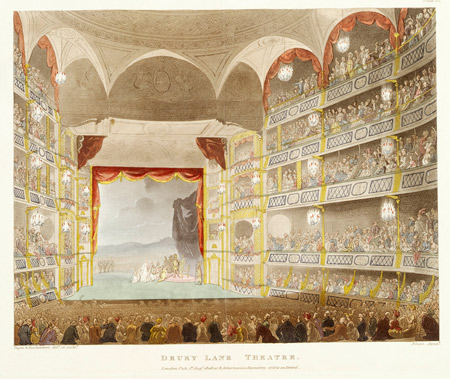
Drury Lane theatre, 1808
Interior view of the Drury Lane theatre filled with an audience watching a performance in progress. ID no. Z1014/1(30)
For our ninth day’s march we were again favor’d with a very fine morning we first call’d on Mrs Brice, then proceeded to the Panarama of Barker in Leicester fields with which we were much pleased, the situation of the town and the fine country around formed a beautiful picture.
We next proceeded to the picture gallery in Pall Mall where my Uncle left us to call upon the Duke of Norfolk. [The collection of John Julius Angerstein at 100 Pall Mall. The building and part of the collection formed the original National Gallery, prior to its move to Trafalgar Square.] In his [uncle's] absence we were highly amused in viewing this very fine collection of most beautiful paintings many of them by the first artists which are all arranged round three long rooms. Numbers of them I should suppose judges would allow to be very well executed and fine specimens of their different merits. My uncle returned to us, and we then went thro St James’s park and Downing Street to Westminster Abbey to view the monuments and survey this venerable edifice which has contained the Ashes of our Monarchs and the remains of numbers of our most celebrated characters for many centuries.
From this antient Pile we proceeded to St Georges fields went thro. the Borough over London Bridge, thro the city and called on Mr Dawes and arrived at our quarters about four. Mrs Baker a very old friend of my Uncle’s call’d and sat half an hour with us. When she left us we prepared for attending Drury Lane Theatre, the immense size and grandeur of this very fine house is beyond description. We were highly entertained with the laughable comedy Wild Oats [by John O'Keefe] in which was introduced the characters of two or three very primitive Quakers quite Originals and which were very well supported. We returned to the Rainbow a little earlier than on the preceeding night and retired to rest soon after eleven.
Day 10: St. Paul's, the Bank and Whitechapel
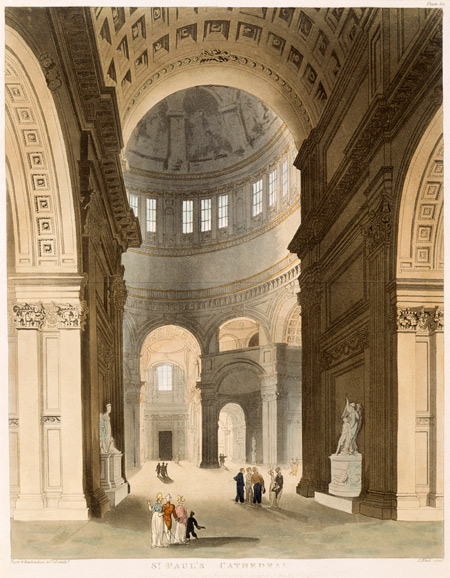
Interior of St. Paul's Cathedral, 1809
From Microcosm of London.
On our tenth morning we commenced our walks directly after breakfast, we passed thro Clare Market Lincoln’s Inn Lincoln’s Inn Fields saw the Surgeons Hall, a noble building and Lincolns Inn gardens. We next bent our course to St Pauls to take a view of the interior of that immense building which is a very grand and noble Structure. It was designed by that great Architect Sir Christopher Wren, there are a few monuments one to the memory of that benevolent character Mr Howard with whom my Uncle had the pleasure of being acquainted. We saw the whispering gallery which is round the grand Dome, where the vibration of shutting a door is like the firing of a cannon.
From this stately edifice we proceeded to the Auction Mart where we were amused with seeing some very fine Paintings which were put up for sale. From thence we visited the Bank where all was bustle and confusion. Here was an assemblage of all descriptions of people buying and selling stock. From there we proceeded to White Chapel a new part of the town to us it is a very long street indeed, we pass’d a coachmakers where a friend of our[s] lived many years ago.
We saw the London Hospital, a noble building. We returned the same way, went thro Cheapside, the Strand and Fleet street and home by four. We took our Tea at Mr Brices, we there met Mrs Baker who appeared greatly to enjoy talking over with my Uncle the many merry and pleasant days they had spent together, after passing two or three hours very agreeably we returned to our Hotel and retired to rest about our usual time.
Day 11: Rainy walks round Covent Garden (Thursday 24 March 1814)
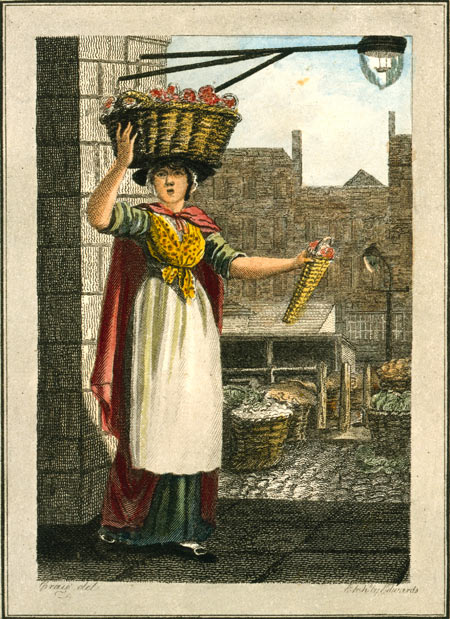
Strawberry seller, Covent Garden, 1804
Engraving, Richard Edwards. A common sight on the streets of London when Elizabeth Chivers visited. ID no. 35.96/1
Our eleventh morning proved rainy we reluctantly saw my Uncle set off his march alone, in the course of the morning the rain abated and we gladly embraced the opportunity of taking a little walk in the neighbourhood of the Rainbow. We had not courage to stroll far being afraid of not easily finding our way back again. My Uncle returned to us a little before dinner, at Seven we took our tea, while at it were serenaded under our windows with very pretty music. In the evening we had resource to our everlasting amusement Back gammon.
Day 12: Elephant, Rhinoceros and camel, oh my! (Friday 25 March 1814)
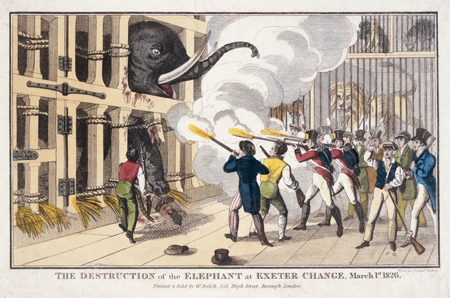
The Destruction of the Elephant at Exeter 'Change', 1826
This unfortunate incident occurred about 12 years after Elizabeth's visit. Chunee the elephant became aggressive after being confined in a small cage, and soldiers were called into shoot him. ID no. 60.43/16
Soon after breakfast on our twelfth morning we once more set off to see a little more of this wonderful place. We went down Cheapside and on to Bonds Change Alley [bankers John Bond & son] where we were a very long time detained. We next bent our course to Mr Alderman Birches where we ate a little of his delightful pastry then proceeded to Exeter Change in the Strand to see the finest collection of wild Beasts in the Kingdom, which is kept and managed by Polito [Polito's Royal Menagerie].
The great variety of animals we here saw quite astonished us, there is an Elephant, Rhinoceros and camel, a Lyon and a number of most beautiful Leopards, several Tygers, Baboon, and Monkeys and a vast many more too numerous for me to notice. In another apartment we saw a collection of most beautiful birds natives of many different countries.
We were next shewn into a Room filled with a wonderful assortment of curiosities, the principle was Mrs Phillips Shell work in which was formed grottos, Temples, flowers etc. which had a very pretty effect. There were many other curious things which was brought from …… Museum. We departed from Exeter Change highly pleased with our visit to it.
We returned to our Hotel about four to prepare for company who we expected to dinner at half past five arrived Captn. Willm. Chivers and his Lady a very cheerful pleasant woman and he a very agreeable man. We enjoy’d their company until ten O’clock at which hour they took their leave.
Day 13: Touring the Tower (Saturday 26 March 1814)

Tower of London, 1819
Watercolour, John Gendall. View of the Tower from the Thames. ID no. 59.60/1
We left the Rainbow soon after ten on our Thirteenth morning. We bent our course to Mr Thornhills Judd St. Brunswick square, we passed St Georges fine church Bloomsbury which has a singular spire on the top of it is a noble statue of one of the Kings. We next took a view of the exterior of the British Museum an immense building in great Russel street and then into Russel Square in it there is a fine Bronze Statue of the late Duke of Bedford on whose property this noble Square was built.
We next arrived at Mr Thornhills with whom we sat about half an hour and then along with Mr Thornhill and his daughter we stepped into a coach and drove to Messrs Bonds where my Uncle put her into possession of the jewls and plate the property of her Uncle the late Revd. Tho. Chivers. Here we parted with them and next proceeded to the Tower in our way we pass’d my Father’s old Wine Vaults in Crutched Fryers and over Tower Hill on which ground many unfortunate noblemen were beheaded in the time of the Rebellion.
We now arrived at the Tower and attended by one of the Yeomen proceeded to view the Armoury, which is a most grand and beautiful sight, the great variety of arms antient and modern, the very beautiful manner in which the small Armoury is arranged indeed it is quite impossible for me to describe the order and wonderful regularity in which they are placed in a magnificent room 345 feet in length. We next visited the Horse Armoury our attention was here directed to a most striking sight a number of our Monarchs from William the Conqueror to George the Second all sitting on horseback and equipped in full suits of armour which many of them wore. The walls of the room are decorated with abundance of uncommon pieces of old armour now so antient that their names and uses are almost unknown.
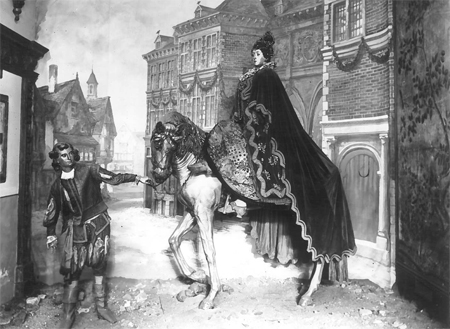
Statue of Elizabeth I on horseback, on display in the London Museum c. 1920
This is the figure of the queen on horseback that Elizabeth Chivers saw in the Tower of London. When the London Museum was founded in 1912, it was lent from the Royal Armoury for display at Lancaster House, and was destroyed during the Blitz.
The Spanish Armoury contains the spoils of the invincible Armada and consists of a very great variety of arms, at the upper end of the room a curtain drew up and we were presented with a noble representation of Queen Elizabeth in the act of delivering her speech to her army at Tilbury camp in the year 1588, the figures represent the Queen, her Horse and her Page, her Majesty is in the very same Armour she wore at the time, with a white silk petticoat ornamented with pearls and spangles etc. Her robe is of crimson satin fringed with gold, her head is adorned with pearls and she has a large ruff round her neck. The horse is cream colour and is richly caparisoned.
We departed from the Tower much pleased and very much astonished with what we had seen. We proceeded thro Mark Lane, where the corn market is held by Ironmongers Hall, to Birches then to Mr Dawes’s and from thence took a view of the Stock Exchange and also had a peep at the Swan and two necks in Lud lane, a charming Inn, in a delightful open airy situation not in the least annoy’d by the noise of stage coaches and waggons Ironically speaking. We pass’d thro Hatton garden saw what was the Pewter plater [?] Lodge. We got home to dine at four, and in the evening reading writing and backgammon.
Day 14: Foundlings and fashion (Sunday 27 March 1814)
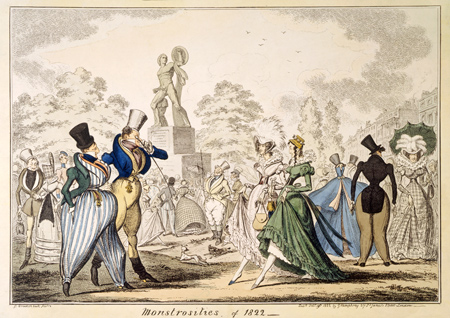
Monstrosities of 1822, George Cruikshank
Engraving satirising society fashions in Hyde Park near the Achilles statue. This was the place for London high society to see and be seen every Sunday. ID no. P888
On Sunday our fourteenth morning we set off to attend the Foundling Hospital. We arrived at it by eleven it is a very noble building it has a large spacious play ground in the front for the children, the Chapel is a very fine one it is very richly ornamented, over the communion Table is a beautiful painting and there are three fine painted windows. There are from two to three hundred of these poor deserted children male and female which is a very pretty sight. We heard an excellent Sermon which was preached to a large congregation.
We returned to the Rainbow and then again set off thro Leicester Square, Berkel[e]y Square and Hertford St. where my Uncle called on some friends. We then proceeded into Hyde park which we had the pleasure of seeing in perfection the morning was very beautiful the immense number of people on foot and the hundreds of elegant carriages and Gentlemen on horseback was an astonishing sight. We walked to the Serpentine River which has been fatal to numbers.
After having walk’d some time in the park we bid adieu to this gay scene. We went down Piccadilly and arrived at our quarters at half past four in the evening. My Uncle read us a long and excellent Sermon at our usual hour we retired to rest.
Read the third and final illustrated extract from Elizabeth Chivers's diary.








